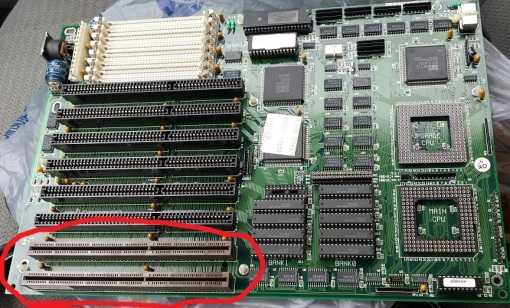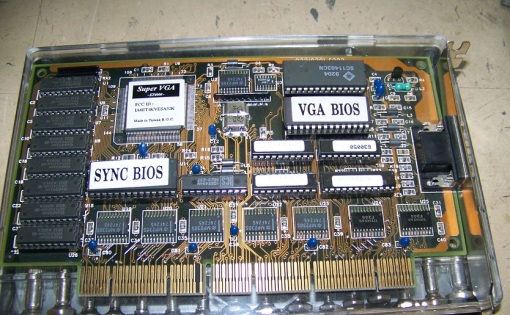One of the great things I love about retro computing and collecting is that it always seems like there is more to discover. Sure in the realm of video game consoles a rare Prototype will pop up time to time such as the SNES Playstation or some game that was almost translated into English but for the most part you need to be very lucky to come across something like that and by and large it feels like it has been talked about to death. Retro computing though seems to hold many more secrets that have yet to be revealed, rare expansion cards that had very low production runs or games that have fallen through the cracks of time and have been forgotten. Another great thing is that because retro computing is so much less popular than console collecting prices and availability are in general much better. It seems much more likely that you’ll stumble on a rare video card or memory expansion card from that 386 you grabbed off Craigslist for $5 then the odds of finding a Little Samson in that NES you probably overpaid for on Ebay. In this Odds & Ends I’m going to share with you two very unique finds that I acquired in the past few months of which very little information exists of and of which a lot of detective work and the help of some very knowledgeable people was necessary to even figure out exactly what I had.
OPTI LOCAL BUS
So what is Opti Local Bus? Basically it is a proprietary form of the VESA or VLB bus found commonly on many 486 motherboards. Those really long brown slots that take the equally long cards.
The VLB slot was designed to take advantage of the faster speeds of the 486 and 486 motherboards offering faster performance then the older 16 bit ISA slots. Before this became standardized into what we know as VLB or VESA slots many motherboard and chipset manufacturers attempted to implement their own version each with different and incompatible cards and slots. The most common of these proprietary slots was the Opti Local Bus slot introduced by Opti, manufacturer of the Opti chipset among other things.
Below is a motherboard with an Opti Local Bus slot, two actually. The board itself is actually of interest being a (possibly) early 486 Chaintech 433SCL. This is interesting because first the BIOS string indicates it’s a BIOS from July 7th 1991 placing it pretty early for a 486 and second because there is NO information on the internet about this particular motherboard, Nothing except the posts made on various forums from me as I tried to identify it. It actually took a lot of detective work by some very savvy vintage computer forum members as well as getting the board to post and looking at the BIOS string to get any information on this board. The Chaintech website archives confirms a Opti Local Bus motherboard was produced in ’92 but that’s all the information that could be dug up on this board from the internet.
The two slots at the bottom that I have circled are the Opti bus connectors in question. If you know a lot about this era of motherboards you may mistake them for EISA slots which is what I thought they were at first. One of the biggest issues with this slot type is that it looks exactly like the somewhat more common EISA slots of the time and will physically accept EISA cards without issue. The problem is installing a EISA card in a Opti bus slot and powering on the board could very well result in a blown out card, motherboard or both. This being the case make completely sure what kind of expansion slot your motherboard is sporting. Fortunately when I found this board in a box of random PC parts at a local monthly electronics fest I also found an accompanying Opti Local Bus video card.
You can tell what kind of card you have by comparing the pinouts with an EISA card and seeing if they match. Also many times a Opti card will have “Local Bus” printed somewhere on it though in this case, mine did not. By checking the FCC ID I was able to determine this card was also manufactured by Chaintech. The card is a 1MB video card based off the Tseng Labs ET4000 chip making it a pretty nice and speedy DOS card. Performance theoretically should be equal to the VLB version but as I never was able to get this motherboard to boot to an OS easily and never put the time into setting it up I was not able to benchmark. I should also note that in all my research I have only seen video cards using the Opti Local Bus connector and all of these were based off the Tseng ET4000 chip.
The Opti bus along with the other even less known proprietary local buses were pretty short lived and came and went before most people even noticed as it was replaced industry wide by the VLB slot standard. As seen on my motherboard the chipset does not have to be Opti based to support the Opti bus. My board for instance is based off of a SIS chipset. Some Leading Edge 486 motherboards and Orchid’s Superboard series also use the Opti local bus and I encourage anyone who comes across a “EISA” motherboard to double check before installing any cards.
Here’s another example of a Opti Local bus board I came across.
You’ll notice this unidentified Opti motherboard at least had the decency to label the slot as a local bus slot. You’ll also notice this one looks pretty much like a VLB bus slot.
And here is the card itself which as expected is based on the Tseng Labs ET4000 chip. It looks as the traces on the back part of the connector all lead to the VGA BIOS. Unfortunately I could not get this motherboard to POST.
DIAMOND SONIC PRO (ARIA CHIPSET)
The second item I have to talk about is the extremely rare Diamond Sonic Pro sound card based upon rare Sierra Semiconductor Aria sound chipset. How rare is the Diamond Sonic Pro? well, like the Chaintech 433SCL motherboard above before I randomly stumbled across this card inside a 486 machine I bought off Craigslist and posted images in an attempt to identify it there were no known pictures of the card on the whole of the internet nor any information on this particular card except a brief mention of its existence in Wikipedia and a dead link to possibly its driver package on the archived Diamond website.
The Aria sound chipset is a surprisingly well supported sound chip supported natively in a number of games from the 90’s including The 7th Guest, Elder Scrolls: Arena and Elder Scrolls: Daggerfall among others and is most commonly found on the also rare Prometheus sound cards that I’m told turn up on Ebay maybe one to three times a year. As far as I know though the Diamond Sonic Pro card has never been on Ebay or at least not that anyone has identified.
The Aria cards MUST be initialized via a software driver to function which for this card presented a problem as the original Diamond drivers are nowhere to be found on the internet except a dead archived link. This forced me to use the drivers for the already mentioned Prometheus line of Aria based cards which fortunately mostly seem to work, at least under MS DOS. When I say mostly its because some utilities seem to work and others do not but at the very least I was able to initialize the card and set the basic I/O address, IRQ and ect… I have no idea what any of the jumpers or switches do as the only information available on this card is pretty much what I’ve supplied here. Interestingly games like Daggerfall gave me issues when setting the I/O address as the only option I have when installing the drivers for I/0 address is 280 and 290 and in the Daggerfall sound setup the highest I/O address selectable is 260. Again this may be an issue with mismatched drivers. another issue with the mismatched drivers is the mixer doesn’t seem to work or it could be my card is actually damaged. In testing games I was only able to get mono sound and some games did not mix audio correctly. I will update this if I can find the correct drivers. Until then I made a short video with some audio samples and comparisons though the Aria mono quality is fairly bad and surly does not do the card justice. As far as I can see at the time of this writing its’ the only example on YouTube of the Aria chipset.
Other then some information on thiese fairly rare and uncommon PC components I hope I got the idea across that the world of retro PC collecting still has some mystery in it and a rare find can still be had by the average guy buying a $5 PC locally. It’s part of the reason I still love retro computer collecting and still discovering new things every day.



































